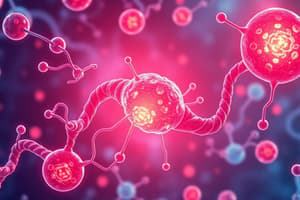Podcast
Questions and Answers
What is one of the first symptoms of certain genetic defects in infants?
What is one of the first symptoms of certain genetic defects in infants?
- Increased appetite
- Periodic vomiting (correct)
- Enhanced energy levels
- Reduced body temperature
What can high levels of NH4 in the body lead to?
What can high levels of NH4 in the body lead to?
- Coma and irreversible brain damage (correct)
- Improved metabolic rate
- Increased protein synthesis
- Enhanced cognitive function
Why are excessive amino acids harmful to humans?
Why are excessive amino acids harmful to humans?
- They produce free ammonia in the blood (correct)
- They increase body weight
- They enhance enzymatic reactions
- They reduce protein synthesis
Which of the following amino acids must be provided in the diet because humans cannot synthesize them?
Which of the following amino acids must be provided in the diet because humans cannot synthesize them?
What role does glutamine play in the context of high levels of NH4?
What role does glutamine play in the context of high levels of NH4?
Which amino acid is classified as essential for humans?
Which amino acid is classified as essential for humans?
What is the abbreviation for Histidine, an essential amino acid?
What is the abbreviation for Histidine, an essential amino acid?
How are the dietary requirements for essential amino acids met in patients with urea cycle defects?
How are the dietary requirements for essential amino acids met in patients with urea cycle defects?
What percentage of the body's energy production is accounted for by amino acid catabolism?
What percentage of the body's energy production is accounted for by amino acid catabolism?
Which is NOT a nonessential amino acid?
Which is NOT a nonessential amino acid?
What enzyme action allows α-keto acid analogues to accept amino groups?
What enzyme action allows α-keto acid analogues to accept amino groups?
Which of the following amino acids is classified as a nonessential amino acid?
Which of the following amino acids is classified as a nonessential amino acid?
Why are individual amino acid degradative pathways not examined in detail?
Why are individual amino acid degradative pathways not examined in detail?
What is the end product of the amino acids Alanine, Cysteine, Glycine, Serine, and Threonine?
What is the end product of the amino acids Alanine, Cysteine, Glycine, Serine, and Threonine?
Which end product is derived from the amino acids Leucine, Lysine, Phenylalanine, Tryptophan, and Tyrosine?
Which end product is derived from the amino acids Leucine, Lysine, Phenylalanine, Tryptophan, and Tyrosine?
Which amino acids are converted to α-ketoglutaric acid?
Which amino acids are converted to α-ketoglutaric acid?
What is the common end product of Isoleucine, Methionine, and Valine metabolism?
What is the common end product of Isoleucine, Methionine, and Valine metabolism?
Which amino acids can yield Fumarate upon metabolism?
Which amino acids can yield Fumarate upon metabolism?
What is the role of amino acids in protein metabolism?
What is the role of amino acids in protein metabolism?
Which amino acid is primarily derived from muscle tissue?
Which amino acid is primarily derived from muscle tissue?
What does the reaction between alanine and pyruvate yield?
What does the reaction between alanine and pyruvate yield?
What is a metabolic consequence of excessive amino acid intake?
What is a metabolic consequence of excessive amino acid intake?
Which compound is considered an alpha-keto acid?
Which compound is considered an alpha-keto acid?
What is the by-product of amino acid deamination?
What is the by-product of amino acid deamination?
Which molecule is NOT involved in the conversion of amino acids?
Which molecule is NOT involved in the conversion of amino acids?
Which of the following amino acids results from the excessive degradation of proteins?
Which of the following amino acids results from the excessive degradation of proteins?
What are amino acids combined with to form proteins?
What are amino acids combined with to form proteins?
How does the body eliminate excess nitrogen from amino acids?
How does the body eliminate excess nitrogen from amino acids?
Which amino acid exclusively belongs to the ketogenic category?
Which amino acid exclusively belongs to the ketogenic category?
Which of the following amino acids can be classified as both glucogenic and ketogenic?
Which of the following amino acids can be classified as both glucogenic and ketogenic?
What is the primary reason that the division between glucogenic and ketogenic amino acids is not sharp?
What is the primary reason that the division between glucogenic and ketogenic amino acids is not sharp?
Which amino acids lead to the formation of acetoacetic acid upon degradation?
Which amino acids lead to the formation of acetoacetic acid upon degradation?
What do nearly all amino acids yield upon breakdown?
What do nearly all amino acids yield upon breakdown?
Which amino acid is NOT classified as glucogenic?
Which amino acid is NOT classified as glucogenic?
Which of the following statements is true about the catabolic end products of amino acids?
Which of the following statements is true about the catabolic end products of amino acids?
Which amino acids are considered to be exclusively glucogenic?
Which amino acids are considered to be exclusively glucogenic?
Flashcards are hidden until you start studying
Study Notes
Liver and Protein Metabolism
- The liver plays a crucial role in protein metabolism, particularly in the deamination of excess amino acids.
- Deamination produces free ammonia, which is toxic to humans.
- Humans require 20 amino acids, but can only synthesize half of them; these are called essential amino acids.
- The liver utilizes the urea cycle to convert ammonia into urea, a less toxic compound excreted in urine.
- People with defects in the urea cycle often suffer from elevated ammonia levels, leading to various health issues.
- The liver can synthesize non-essential amino acids using the α-keto acid analogues of essential amino acids, which accept amino groups from excess non-essential amino acids.
- Amino acid catabolism contributes only a small portion (10-15%) to the body's total energy production.
- Amino acid degradation pathways differ significantly, making the classification of amino acids into glucogenic, ketogenic, or both complex.
Glucogenic and Ketogenic Amino Acids
- Glucogenic amino acids can be used to synthesize glucose through gluconeogenesis.
- Ketogenic amino acids are degraded into ketone bodies, which can be used for energy production.
- Both glucogenic and ketogenic amino acids can be converted into both glucose and ketone bodies.
End Products of Amino Acid Metabolism
- Most amino acids are degraded into pyruvate, acetyl-CoA, or intermediates of the citric acid cycle.
- Five amino acids (Leucine, Lysine, Phenylalanine, Tryptophan, and Tyrosine) are exceptions, producing acetoacetic acid, which is also converted to acetyl-CoA.
Ten Amino Acids Degraded to Acetyl-CoA
- Five amino acids (Alanine, Cysteine, Glycine, Serine, and Tryptophan) are degraded to acetyl-CoA via pyruvate.
- Five amino acids (Leucine, Lysine, Phenylalanine, Tryptophan, and Tyrosine) are converted into acetyl-CoA and/or acetoacetyl-CoA, which is then cleaved to form acetyl-CoA.
Studying That Suits You
Use AI to generate personalized quizzes and flashcards to suit your learning preferences.




